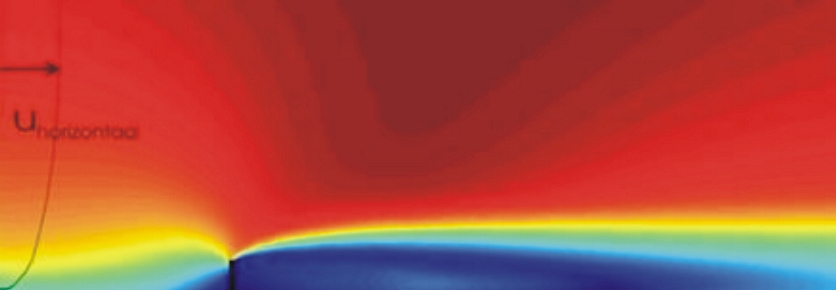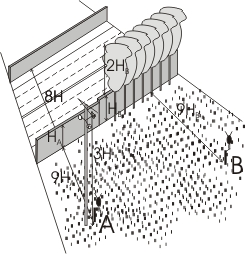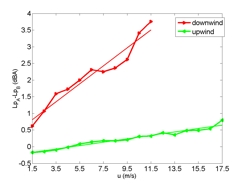Trees as windbreaks
A row of trees acting as a windbreak has been used since centuries in agricultural applications to limit negative effects of wind. In addition, placing a row of trees behind a noise wall is relatively inexpensive, widely applicable and helps to integrate the noise wall in the landscape.
An extensive study
The study consisted in a wind tunnel experiment at scale (Act. Ac. Ac. 88, 231-238, 2002), in a field monitoring (Act. Ac. Ac. 88, 869-878, 2002) and in numerical calculations to optimize parameters involved, by combining CFD analysis and FDTD calculations (Act. Ac. Ac. 89, 764-778, 2003). The use of a vegetation screen behind a noise wall was considered to be a good solution to counteract screen-induced refraction of sound by wind.
The positive effect of a row of trees is not limited to strict downwind propagation. For wind directions up to 45 degrees relative to the exact orthogonal direction, only less than 1 dBA of the net efficiency of the trees was lost in a realistic road traffic situation. In case of upwind sound propagation, a significant worsened situation is not observed.
The presence of a row of trees behind a noise wall results in increased sound pressure levels at high frequencies due to scattering on the canopy of the trees. Typical traffic noise, however, produces only a small amount of acoustic energy in the high-frequency range relative to lower frequency bands. So the contribution of this scattered sound to the total A-weighted sound pressure level is small.
Coniferous trees are preferred
Detailed numerical analysis lead to the conclusion that conifers are more suited than deciduous trees to improve the wind field near noise barriers (J. Acoust. Soc. Am. 123, 648-657, 2008). Their typical needle area densities and canopy element drag coefficients lead to larger pressure resistance coefficients. Further, their canopy shape is usually close to the optimal triangular form, and during winter, there is no significant loss in biomass.
Effect at long distance
This positive effect of the canopies on noise wall performance is partly caused by reducing wind momentum, but also by shifting the gradients in the wind speed (more precisely to the canopy top). While very strong cancelling of the wind effect is possible at short downwind distance, negative effects might appear at longer distance. A solution here is allowing for gaps in between the bottom of the canopy and the barrier top. The latter leads to a globally optimized noise barrier behavior over long distance under downwind conditions. However, the absence of such gaps stays optimal for receivers at short distance ("Designing canopies to improve downwind shielding at various barrier configurations at short and long distance", T. Van Renterghem, D. Botteldooren; Proceedings of the 21th international congress on acoustics (ICA 2013), Montreal, Canada).
Berms are an interesting alternative
Because of their more aerodynamic shape, noise berms (earth mounds, bunds) are quite resistent to these negative downwind effects. With decreasing internal berm slope angle, wind refraction nearly dissapears. Vegetated berms were shown to be able to compete with noise walls of similar top height in a long-term noise assessment including wind effects (Landscape Urb. Plan. 105, 199-210, 2012). Another acoustical advantage of a berm is the preservation of the ground effect, especially relevant when a berm is vegetated (Env. Mod. Software, 109, 17-31, 2018).
Figure 1
Wind field near a single noise barrier. The horizontal component of the wind velocity is shown (in m/s). The large gradients in the wind speed above the acoustic shadow zone of the barrier lead to downward refraction.

Figure 2
The positive effect of a row of trees behind a traffic noise barrier increases significantly with wind speed in case of downwind sound propagation. This was found based on a field monitoring (Act. Ac. Ac. 88, 869-878, 2002). A direct comparison of the sound pressure level between part of a noise barrier with (B) and without (A) a row of trees was made, at close distance. For a wind speed of 11 m/s, about 4 dBA efficiency was recovered by the presence of the trees.


Figure 3
Contour plots of the positive effect of a row of trees behind a 4-m high noise barrier (in dB), with optimal parameters (J. Acoust. Soc. Am. 123, 648-657, 2008). The x-axis shows distance towards the noise barrier (in m), the y-axis the height above the ground (in m).
![]()